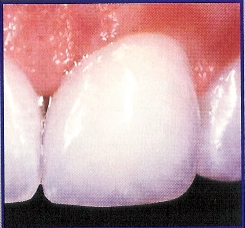|
Home
Implants
Dentures
Children
Cosmetics
| |
-
 
Veneers
Veneers are thin shells that are laid onto the teeth and bonded to the
surface. Although they can be made of different materials, I just use
porcelain, because of its durability and realistic appearance. Veneers are
a more conservative alternative to crowns since they require less removal of the
tooth's original surface. With veneers in place, patients can expect straighter,
whiter, and more even teeth.
The Procedure
During the initial visit, the patient and dentist discuss the process of placing
veneers and the options available (e.g. types and shades of veneers). On your
next visit, the dentist removes a very small layer of each tooth's outer enamel.
A local anesthesia may be used but could not necessary. The dentist makes
a mold of the teeth and then sends it to a dental lab where they create
customized veneers for the teeth. The lab prepares the veneers in roughly seven
to ten days. During this time, the teeth have a slightly different appearance
because of the removal of the outer layer of enamel. Some patients choose to
have temporary restorations placed on their teeth, but this step is usually not
necessary. Once the veneers have returned from the lab, the patient makes a
final dental visit. The dentist applies the veneer to the tooth using a bonding
material. When exposed to light, this bonding material dries and hardens.
Following the Procedure
Patients may experience some sensitivity in the teeth, especially when
contacting hot or cold substances. This sensitivity should lessen within two
weeks. If you grind or clench your teeth while you sleep, your dentist can fit
you with a mouthguard that will protect your teeth. Veneers are quite strong and
can withstand considerable force when a patient bites down, but they may
fracture or break if twisted. Patients should therefore avoid hard or sharp
foods such as ice or pistachios that may cause undue stress. Veneers should be
cared for in much the same way as normal teeth; this includes daily brushing,
flossing, and periodic checkups with a dentist. Given the proper care, veneers
can preserve a smile for decades.
Regardless of how well you care for your teeth, it is
inevitable that, over time, some yellowing or discoloration will occur. This
gradual change can be caused by aging, substances that stain your teeth (such as
coffee and tobacco), excessive fluoride, or the deterioration of a tooth's
nerve. A tooth whitening treatment can be performed either as an at-home,
dentist-supervised process or in the dentist's chair. While neither of these
methods stops future discoloration, these treatments bring about whiter teeth
and help create a brighter smile.
Crowns
Crowns, also called caps, fit snugly over
teeth to mask chips, broken teeth, misalignment, stains, and other
imperfections. Crowns can immediately enhance your smile by brightening your
teeth and making them much stronger. There are three different types of crowns:
Metal - this type of crown can be made of gold alloy, palladium, nickel alloy,
or chromium alloy. Metal crowns are ideal for use on the back teeth. Ceramic -
Ceramic crowns look like normal teeth and are ideal for use on the front teeth.
Porcelain fused to metal (PFM) - PFM crowns are stronger than ceramic crowns and
look like normal teeth. To learn more about crowns or other cosmetic dentistry
procedures, please contact Dr. Goodin today. He welcomes cosmetic dentistry
patients.
|

